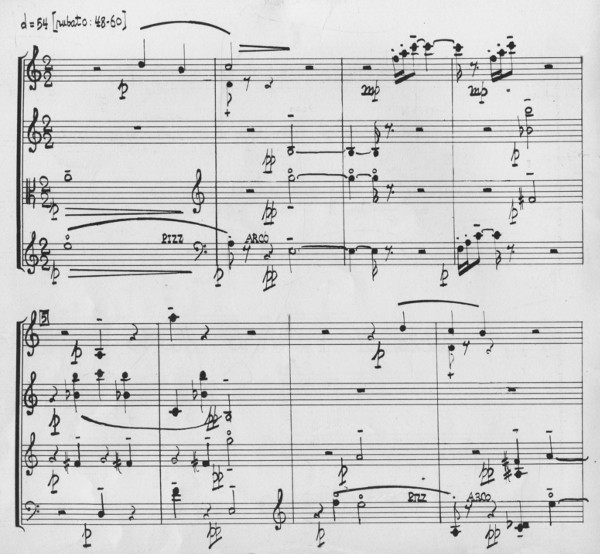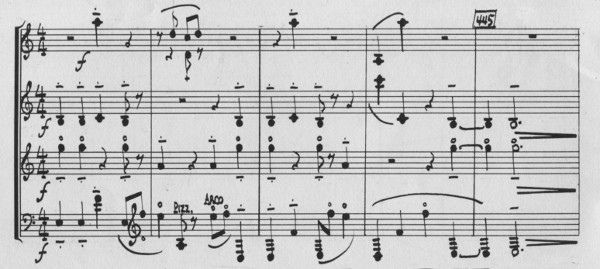
[This is part of the series Opening the door into emptiness]
In March 1949, John Cage went to Europe. He traveled in Holland and Italy, but spent most of his time in Paris, where he met composers and searched for obscure works by Satie. He wrote home to his parents frequently, and described his search for a way forward in his music. “My new music ideas are proving more and more interesting to me,” he wrote in May, “but they are so new in conception to me that I still can’t quite grasp them, and I begin to want to know whether they will work or not.” In June he found a space with a piano in which he could work. The music came slowly at first (“my mind isn’t clear enough yet to get anywhere”), but by August a string quartet started to take shape. This was the beginning of his masterful String quartet in four parts, which he completed after his return to New York.
Silence was at the heart of Cage’s new ideas. “Without actually using silence, I should like to praise it,” he reported to his parents. It was not a physical silence, and it was not the “sounding silence” of ambient noise that he would embrace later. Silence here meant the ideas about emptiness Cage had expressed in “Forerunners of modern music”. In a section of that article labeled “Claim”, he described for the first time the fundamental emptiness of musical structure based on duration: “Any sounds of any qualities and pitches … are natural and conceivable within a rhythmic structure which equally embraces silence.” Structure was silent about the sounds that went into it. And now “structure” meant any system applied to any element of music. He saw compositional rules as mental and musical disciplines that could help to empty him of the ambitions of ego, and achieve a music that was more free: “self-knowledge through self-denial”. But he had no clear direction on how to create the continuity within this emptiness. He needed to start composing in order to discover the music within the silence.
As with any composer, Cage discovered the way forward through the ups and downs of the creative process. At the start of a letter from August 27th, he reported difficulties:
I have run into problems with my new piece; I have not yet found the way for it to be a String Quartet. It is as though I had decided to write a String Quartet and then without realizing it written something else that I don’t know about.
But then later in the same letter, he reported success: “And my music solved itself — is a quartet and I am happy about it.” What Cage discovered—or in his terms, what his music discovered and “solved itself”—was how to treat harmonic materials in a systematic way.
Cage devised a methodical arrangement of the individual harmonies that formed the musical world of the quartet. He described it in a letter to Pierre Boulez:
The Quartet uses a gamut of sounds, some single and some aggregates, but all of them immobile, that is staying always not only in the same register where they originally appear but on the same strings and bowed or produced in the same manner on the same instruments.
These harmonies were related to one another in the music solely by their top notes, which supported the melody line of the quartet. For instance, consider the opening of the last movement:

The melody line here starts on a G (in the viola) and moves mostly stepwise up and down between C below and the A above. Cage’s system of fixed sonorities means that, every time the melody lands on specific tones in that range, they are always scored in exactly the same way with exactly the same sonorities. The C is always in the first violin with a short D underneath and a pizzicato C in the cello. The D is always a single note in the first violin. The E is always a harmonic in the cello with an A in the viola, and so forth.
The combination of the static voicing of the harmonies and this somewhat arbitrary rule for connecting them created unusual sequences, a kind of harmonic “non-progression.” Prior to this, Cage made various arguments against harmony: he described it as leading to “an island of decadence” in “Defense of Satie”, for example. The technique of the new string quartet used harmony in a non-structural way, which weakened any sense of progression or directed movement. Cage had discovered a non-expressive use of harmony, and he had done it by treating materials in a systematic fashion.
This created the unique sound of the string quartet. Paradoxically, by consciously setting up a structured arrangement of his selected harmonies, Cage let go of conscious control of the harmonic continuity. The path of the String quartet in four parts did indeed lead to “self-knowledge through self-denial,” as Cage had predicted in “Forerunners of modern music”. Here was a music that was, (at least harmonically) free of the merely personal. Each individual sonority stands out, alive and vibrant on its own. The sense of motion in the piece comes entirely from the gentle melodic line (which comes to a standstill in the third movement, marked “Nearly stationary”). The lack of vibrato in the playing also contributes to the static feeling. This truly is a string quartet that “praises silence”: an austere music coming from an emptiness beyond time. When the composer Jacques-Louis Monod asked him where he was trying to go in the quartet, Cage replied: “nowhere.”
Cage saw the string quartet as a breakthrough. After completing the first movement, he wrote to his parents that “this piece is like the opening of another door; the possibilities implied are unlimited and without the rhythmic structure I found by working with percussion and the newness, freshness of sound I found in the prepared piano, it would be impossible.” Cage’s music was now a world of sounds of all kinds—traditional harmonies, even—appearing within empty spans of time. Their concreteness, unburdened by personal self-expression, pointed directly to the universal emptiness behind them. Cage was now on a path of discovery through composition; he was beginning to realize the generative power of emptiness, of “Nothing”.
Read the next post in this series: 6 — The poetry of sounds
Sources & asides
Cage’s letters to his parents from his 1949 European trip are currently housed in the John Cage archives at the Northwestern University Music Library. The Cage-Boulez correspondence is there as well, and has been edited by Jean-Jacques Nattiez and translated by Robert Samuels (The Boulez-Cage correspondence, Cambridge University Press, 1993).
For a full description of the composition of the string quartet, see my book The music of John Cage (Cambridge: Cambridge University Press, 1993), pp. 47-55. It is worth pointing out that the quartet is not as systematic as it appears from my description. As I try to point out here, it was a process of discovery, not something that followed a preconceived plan. Cage’s letters from Paris make this clear, especially his concern when he couldn’t find the way to make it a string quartet. Presumably he was composing at the piano, but had not yet decided on the plan of a collection of harmonies fixed in their instrumentation. Perhaps he knew that he would limit the harmonies, but hadn’t figured out the fixed instrumentation part of the system. This is suggested by a passage, later in the same letter he makes the intriguing announcement that “Tomorrow morning I will finish the instrumentation of the first movement.” It would be helpful to have some sketch or draft materials for the quartet, but, alas, these do not exist.

Where is the source of your quote regarding the Monod question raised to Cage? I doubt Monod ever met Cage nor had any interest in Cage’s music.
It’s from a letter from Cage to Pierre Boulez in 1950:
The Boulez-Cage correspondence, J.-J. Nattiez, ed., R. Samuels, trans., Cambridge University Press, p. 56
Thank you for replying with the reference. Evidently your source appears genuine: if Cage knew J.-L. Monod – and unbeknownst to me – there has never been any indication in the many years which I knew and studied under Monod that he was ever remotely interested in Cage’s music, since both were diametrically opposite in their interpretation of the music of their common Master, namely Schoenberg. In fact Monod – who took Schoenberg’s musical legacy to another direction – has been dismissive of Cage’s music – which I now consider somewhat premature, given Cage’s exhaustive examination and explorations of Schoenberg’s music and “inventiveness”. Although there has been ongoing “musical and personal differences” between Monod and Boulez since their time (1940s) studying under Leibowitz, this interesting anecdotal story on the other hand between Cage and Monod merits further attention and historical inquiry.
Further, if Cage had written to Boulez as early as 1950, this date implies Cage had known or met Monod either immediately after Monod had relocated to NYC (1950) or he met Monod in Paris. Also, Monod had never had a conversation with Boulez, although both attended Messiaen’s classes on harmony and analysis at the Conservatoire. Thus it is surprising that Cage would even consider writing to Boulez regarding Monod’s supposed “scandalized” reaction to Boulez’ article in Contrepoints, since Monod may likely have been disinterested in Boulez’ work at the time (remember that in 1950 and earlier, Boulez has yet to make his mark in avant-garde circles as the “enfant terrible”). Again the 1950 letter from Cage to Boule regarding Monod’s supposed reaction to Cage’s Quartet is intriguing and deserves further inquiry.